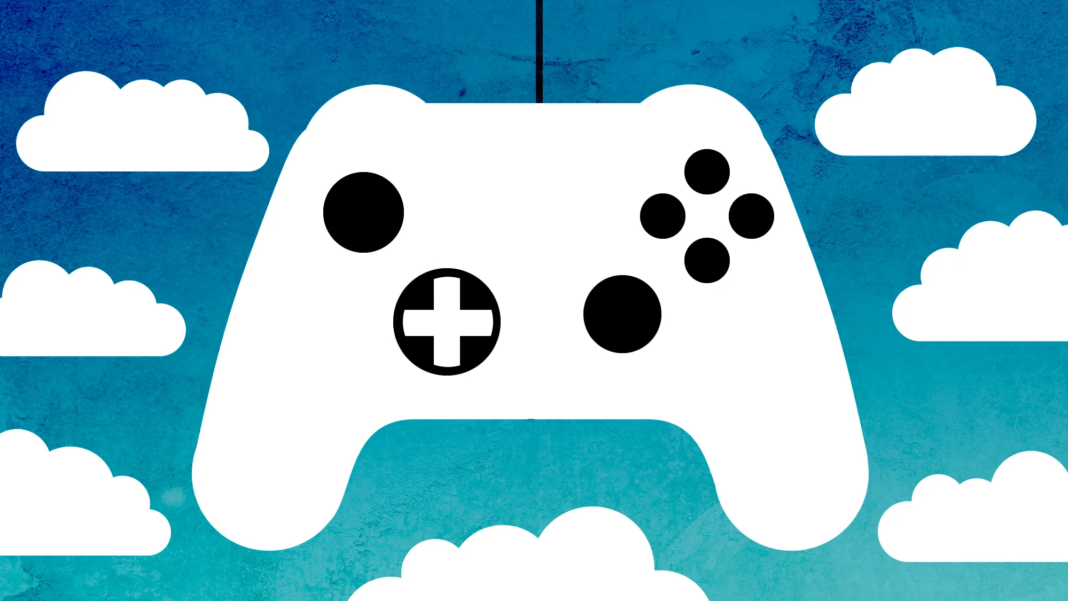Cloud gaming is a subcategory of cloud computing. Like movies and series, games are delivered via streaming services to the user’s own terminal, which is exclusively content. In this article you will learn more about cloud gaming, technical details , pros and cons, and on the best cloud gaming offerings .
Cloud gaming explained in a simple way
The expression “storing something in the cloud” has become an everyday term. It means that the data is stored outside your own computer or home network in an online storage space. This is also true of cloud games, except these are games that don’t end up on the home computer’s hard drive, as is traditionally the case, but are delivered directly from the cloud game provider’s data center
Games, some of which are operationally demanding, run on servers in the data center, so players don’t need a powerful terminal to match. Audio and video signals are transmitted to the player over the internet connection. The actions carried out by the player through the mouse, keyboard, gamepad or other peripherals take the reverse path through the broadband connection.
Cloud gaming has not yet established itself as a full-fledged alternative for gamers, but it is still a comparatively young software development services for gaming on PC or console. Until now, players purchased their games in physical or digital format, installed or downloaded them and then had permanent access subject to registration in an online account such as Steam, Origin or Ubisoft Connect. Additionally, there used to be the option to play single-player content offline, something that is typically not possible when streaming via cloud gaming.
Summary of the main cloud gaming providers
- Project xCloud/xBox Cloud-Gaming
- Google Stadia
- PSNow
- GeForce Now
Requirements for cloud gaming
The most important requirement for a smooth gaming experience through cloud gaming is a stable internet connection with high bandwidth . It is not possible to give a general answer for all games regarding the average data transmission speed for smooth streaming, as data packets of different sizes are sent and received depending on the requirements of the games. However, anyone looking for an approximate guideline value should choose a rate that provides a minimum bandwidth of 75 Mbit/s.
In addition to the technical requirement, cloud gaming also requires adequate hardware. It can be a simple computer or laptop. But gaming consoles, such as the Playstation 4, which is suitable for Sony’s streaming service, PS Now, as well as a PC or even (mainly) Android devices, such as smartphones or tablets, are also suitable for remote gaming. The user’s compatible terminals largely depend on the cloud gaming provider .
Advantages of cloud gaming
No sophisticated hardware required
You don’t need it: a high-end PC or a modern gaming console that can display games in all their graphical glory using its own hardware. This is one of the main advantages of streaming games over the internet. The often tedious adaptation of system components or the purchase of completely new computers is eliminated , saving a lot of money.
In the case of console games, the cycles are much longer due to the longer duration of the different generations (example: Playstation 4: 2013-2020), but also in this case the hardware is subject to constant improvements. Those who choose cloud gaming and have a strong internet connection don’t have to worry about system requirements, driver updates, compatibility issues, and updates. All of this falls on the cloud gaming provider and is done in on-site data centers.
Another advantage: since the hardware itself is less stressed, the devices heat up less and therefore also require less cooling. This is not only good for technology, but also for the human ear .
Simple savings
Cloud gaming is a storage paradise in two aspects:
For one thing, you no longer have to worry about available storage space on your own hard drive(s). You will no longer have to check if there is still enough memory space and you will never have to uninstall a game again to make room for the latest addition to the collection. Whatever the storage needs, organizing the available space is the responsibility of the cloud gaming provider. On the other hand, players have the option to save their games and game profiles directly to the provider’s space. It is the most convenient way to avoid the loss of saved data . Additionally, game progress is automatically available on any device as soon as you log in to your account.
Location Independent Gaming
In addition, players are more independent with cloud gaming. As long as there is a stable internet connection, you can play your favorite games almost anywhere, without having to always carry your PC or gaming console, including cables, controllers and games.
Time saving
Another advantage of cloud gaming is the enormous time savings that its use represents. All games are installed by the provider and are constantly kept up to date. Therefore, as a user, you don’t have to spend time downloading files or installing and updating a game. Thus, cloud gaming provides the classic “plug & play” experience, which, today, consoles no longer guarantee. This advantage is especially noticeable in high-volume game titles.
What are the disadvantages of cloud gaming?
Dependence on internet connection
Compared to traditional gaming, the reliance on internet connectivity is the biggest disadvantage of cloud gaming is t If you have a good network that also stays consistent at all times, there shouldn’t be too many barriers to enjoying the game.. With less powerful connections , data transmission that is too slow can lead to screen skips, reduced resolution, and delayed input.
Availability of titles is not guaranteed
Another great disadvantage of cloud gaming: games are no longer purchased for permanent use, but rather a license for limited use is acquired in time. The respective cloud gaming providers constantly expand and modify the available offer. It is not guaranteed that titles will remain part of the catalog forever. If the provider wants to remove a game from the catalog or does not want to renew its own user license, players have nothing to do.
The offers are very different
Another drawback is the offer, which varies greatly from one provider to another:
- It is true that Microsoft’s Game Pass contains a relatively large number of current games, and that the most notable upcoming titles will also be included there immediately at launch or shortly after . However, this situation remains the exception until now.
- Sony’s offering, for example, is still quite small (although it adds points thanks to the exclusivity of many old titles).
- Google Stadia or the GeForce Now streaming service, belonging to the graphics card manufacturer NVIDIA, are not convincing either in terms of quantity or topicality .
If we also take into account that both Microsoft and Sony cover the long-term financing of their consoles with the sale of games, mostly exclusive titles, we conclude that there are at least doubts that the new flagship releases are always available directly through cloud gaming at a monthly price well below its value, from the manufacturer’s point of view.
Limitations in the gaming experience
What for a user is a hassle-free gaming experience, for a tech-savvy optimizer is a major drawback of streaming technology. Those who like to adjust settings, install mods and experience the game with the best graphics may not be satisfied with cloud gaming.
The quality of the graphical output is also limited by the streaming service provider. For the main cloud gaming providers, the current limitation is 1080p, that is, Full HD. If your own monitor or television supports higher image quality, the resolution is usually reduced. Google Stadia exception: the cloud gaming service also supports viewing in 4K resolution with up to 60 frames per second for some titles, but only with the Stadia Pro rate.
But the limitations don’t just affect graphics settings. PC gamers, especially, will miss many freedoms in cloud gaming. For example, it is not possible to create your own servers and freely define the rules of competitive or cooperative interaction. Players do not have the ability to create, manage or moderate a Minecraft server . This is only possible through the classic PC version, which is installed on the user’s own system and starts there every time it is opened.
Subscriptions do not include all titles
In short, this kind of “Netflix for video games” is still half done. Depending on the provider, games may have to be purchased individually, but can still only be played through the streaming service as part of the catalog. Some services allow you to download games to your own system, others do not. Furthermore, interfaces with other platforms, such as Steam, are often only partially implemented , which can lead to errors and, in the worst case, unnecessary double purchases of a game.
Cloud gaming and the important question of latency
Latency, also called response time, is an important factor when it comes to rating the playability of multiplayer games . It marks the period that passes between an event that occurs in the game and the appearance of the perceptible reaction to it. Latency time is often called “ping” in Internet jargon and is indicated by a three-digit number in the unit of milliseconds or displayed by several green, yellow, or red bars (analogous to mobile phone coverage or Wifi).
For a multiplayer game to run smoothly, the ping must be very low . It is true that other factors also influence, such as, for example, the fact that there are more devices in the same home using the Internet connection and transmitting high-volume data packets. However, generally speaking, it is worse for latency if all game content is first transferred from the outside to the computer itself and the input made must also be processed by the server first. This fact inevitably affects performance and, therefore, latency.
Currently, all custom software development company and cloud gaming providers can guarantee, in principle, low latency, although the actual result always depends on the bandwidth of the connection itself and the load of other devices on the network.
Player ratings are very positive in most cases. Only in games that require a higher reaction speed, such as competitive online shooters, can you experience latency compared to powerful gaming PCs, thus affecting the gaming experience. Games that run at a normal pace can be played perfectly through cloud gaming.
Author Bio:
Glad you are reading this. I’m Yokesh Shankar, the COO at Sparkout Tech, one of the primary founders of a highly creative space. I’m more associated with digital transformation solutions for global issues. Nurturing in Fintech, Supply chain, AR VR solutions, Real estate, and other sectors vitalizing new-age technology, I see this space as a forum to share and seek information. Writing and reading give me more clarity about what I need.








